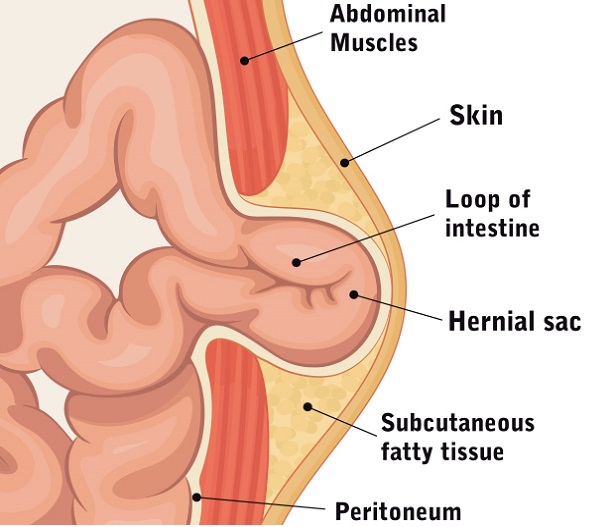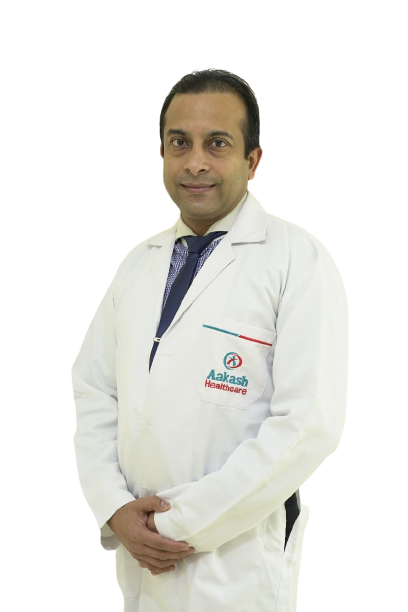Dr. Rajat Goel is regarded as one of the best Laparoscopic Hernia Surgeon in Delhi NCR. With over 10,000 laparoscopic operations under his belt, he has 20 years of experience in general and specialized laparoscopic surgery. He specializes in all facets of general surgery, both open and laparoscopic. He is also very involved in research, having written 19 international publications, over 100 abstracts, and four book chapters, as well as holding all possible sociability and integration.
What is Hernia?
When an organ pushes through a hole in the muscle or tissue that keeps it in place, it is called a hernia. The intestines, for example, could pass through a weak spot in the abdominal wall. Hernias often occur between the breastbone and the hips, but they may also occur in the upper thigh and groin. While most hernias aren’t instantly fatal, they don’t go away on their own. To avoid potentially serious medical problems, they can require hernia surgery.
Symptoms of Hernia
- A bulge or bump in the impacted region is the most prominent indication of a hernia. An inguinal hernia, for example, can cause a lump on either side of your pubic bone, where your groin and thigh meet.
- You might notice that the lump goes away when you lie down. When you’re standing up, leaning down, or coughing, you’re more likely to feel the hernia by contact. There may also be distress or pain in the region around the lump.
- Other hernias, such as Hiatal hernias, have more clear signs and indications Heartburn, difficulty swallowing, and chest pain are examples of these symptoms.
- Hernias often go undetected. You may not be aware that you have a hernia until it is discovered during a regular physical examination or a medical examination for a different issue.
Diagnosis of Hernia
Your doctor will first conduct a physical examination to analyze your illness. Your doctor can feel for a bulge in your abdominal or groin region that gets bigger when you stand, cough, or strain during this test. Your medical history will then be taken by your doctor. He’ll almost certainly use imaging scans to help him diagnose them. This may include the following:
- Abdominal ultrasound creates an impression of the structures within the body using high-elevated sound waves.
- CT scan, which creates an image by combining X-rays and computer technology.
- An MRI scan creates an image by combining strong magnets and radio waves.
If a hiatal hernia is presumed, your primary care physician can perform additional tests to evaluate your stomach’s internal position:
- Gastrografin, also known as barium X-ray, is a collection of X-ray images of the digestive system. After you’ve finished drinking a liquid containing diatrizoate meglumine and diatrizoate sodium (Gastrografin) or a liquid barium solution, the pictures are taken. Both are visible on X-ray images.
- Endoscopy is a procedure in which a small camera connected to a tube is threaded down your throat, into your esophagus, and into your abdomen.
Hernia in Babies
An umbilical hernia affects between 10% and 25% of infants, according to a report. Babies born early or with a low birth weight are more likely to develop this form of hernia. Umbilical hernias are a form of hernia that develops near the belly button. They shape when the muscles covering the umbilical cord’s hole fail to close properly. A part of the intestine bulges out as a result of this.
In the event that if your child has an umbilical hernia, it might be more noticeable when they weep or cough. Umbilical hernias in children are usually painless. However, if you experience symptoms like pain, vomiting, or swelling at the hernia site, you can seek medical help right away. If you suspect your child has an umbilical hernia, consult your child’s pediatrician. Umbilical hernias usually disappear by the time a child reaches the age of one or two. If it doesn’t go away by the age of five, hernia surgery umbilical may be used to cure it.
Hernia during pregnancy
In case you’re pregnant and believe that you have a hernia, make certain to see your PCP. They can assess it and decide whether it represents any wellbeing chances. Frequently, hernia fix can stand by until after conveyance. Notwithstanding, if a little hernia that is available previously or during the pregnancy starts to get bigger or cause distress, medical procedures might be encouraged to fix it. The favored chance to do this is during the subsequent trimester.
Hernias that have been treated in the past can reappear during subsequent pregnancies. Since pregnancy puts a strain on abdominal muscle tissue that has already been damaged by surgery, this is the case. Cesarean deliveries, also known as C-sections, will result in hernias. An incision is made into the abdomen and uterus during cesarean delivery. These incisions are then used to deliver the infant. At the site of a cesarean delivery, an incisional hernia may develop.
Treatment of Hernia
Surgical surgery is the best way to successfully cure a hernia. The extent of your hernia and the severity of your symptoms will determine whether or not you need surgery. Your doctor
may simply want to keep an eye on your hernia for any potential complications. This is referred to as watchful waiting.
Wearing a truss can help relieve hernia symptoms in some cases. This is a supportive undergarment that aids in the retention of the hernia. Before using a truss, you should always consult your doctor to ensure that it works properly. Over-the-counter and prescription drugs that minimize stomach acid can help alleviate pain and improve symptoms if you have a hiatal hernia. Antacids, H-2 receptor blockers, and proton pump inhibitors are examples.
Types of medical procedures
If your hernia is getting bigger or causing you pain, your surgeon can recommend surgery. During surgery, they can sew the hole in your abdominal wall closed to repair your hernia. Patching the hole with surgical mesh is a popular method.
Open or hernia surgery by laparoscopic may be used to treat hernias. A small camera and miniature surgical instruments are used in laparoscopic surgery to treat a hernia with just a few small incisions. It is much gentler on the underlying tissue. The surgeon makes an incision close to the hernia’s location and then moves the bulging tissue back into the abdomen during open surgery. They then stitch the area shut, often using surgical mesh to reinforce it. Ultimately, the incision is closed.
Laparoscopic surgery is not appropriate for all hernias. If your hernia necessitates open surgery, your surgeon will consult with you to decide what is best for you.
Recuperation of Hernia
It’s important to know the symptoms of a hernia and seek medical attention if you believe you have one. An untreated hernia will not heal on its own. Your doctor will examine your hernia and decide the best course of action. Hernias can lead to life-threatening complications. If you have symptoms of nausea or vomiting, a fever, or sudden pain, you should seek emergency medical attention.
Symptoms can be reduced with early medical treatment and lifestyle changes. A hernia, on the other hand, can only be successfully treated with surgery. To fix hernias, a number of operations are possible, and your surgeon will guide you on which one is best for you.
Hernia repair surgery has a strong prognosis, but it can vary depending on the type of hernia, the symptoms, and your overall health. Hernia surgery after effects also includes that it may recur after repair in some cases.








